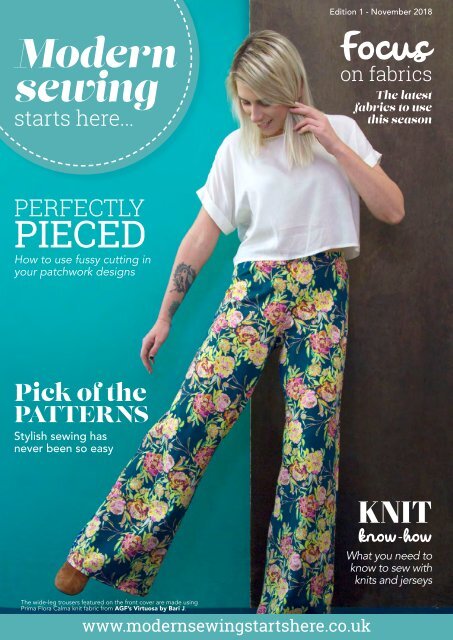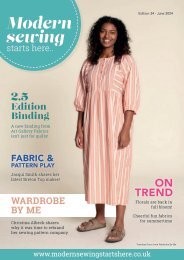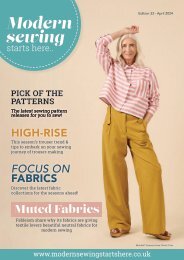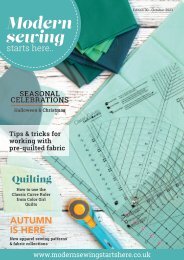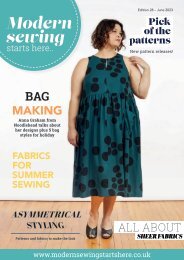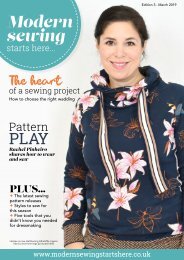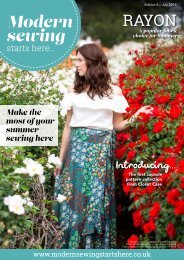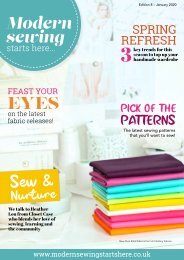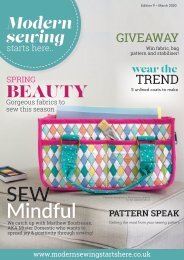Modern Sewing Starts Here Edition 1
Modern Sewing Starts Here is the digital mini-mag from Hantex, distributor of modern, sassy, and super-quality products for sewing enthusiasts at the cutting edge of creativity. We bring you interesting features each month from key figures in the sewing world and keep you bang up to date with what's new. Cost? ... it's FREE
Modern Sewing Starts Here is the digital mini-mag from Hantex, distributor of modern, sassy, and super-quality products for sewing enthusiasts at the cutting edge of creativity.
We bring you interesting features each month from key figures in the sewing world and keep you bang up to date with what's new.
Cost? ... it's FREE
Create successful ePaper yourself
Turn your PDF publications into a flip-book with our unique Google optimized e-Paper software.
<strong>Edition</strong> 1 - November 2018<br />
<strong>Modern</strong><br />
sewing<br />
starts here...<br />
Focus<br />
on fabrics<br />
The latest<br />
fabrics to use<br />
this season<br />
PERFECTLY<br />
PIECED<br />
How to use fussy cutting in<br />
your patchwork designs<br />
Pick of the<br />
PATTERNS<br />
Stylish sewing has<br />
never been so easy<br />
KNIT<br />
know-how<br />
What you need to<br />
know to sew with<br />
knits and jerseys<br />
The wide-leg trousers featured on the front cover are made using<br />
Prima Flora Calma knit fabric from AGF’s Virtuosa by Bari J.<br />
18<br />
www.hantex.co.uk<br />
www.modernsewingstartshere.co.uk
Editor’s Letter<br />
Hello<br />
Welcome to our first edition of our mini magazine for all those who love textiles<br />
and sewing, which we will be publishing every two months. We’ll keep you posted<br />
of exciting new and contemporary product launches including sewing patterns and<br />
fabric, as well as popular techniques that we know you’ll want to hear about.<br />
To make sure you don’t miss the next edition – subscribe free here.<br />
Happy sewing!<br />
WIN WIN WIN!<br />
For a chance to win one of<br />
three fabulous Art Gallery<br />
Fabrics ColorMaster boxes or<br />
bundles we have to giveaway<br />
– just click here to enter.<br />
Closing date is 31 st<br />
December 2018<br />
Hantex<br />
www.hantex.co.uk<br />
www.modernsewingstartshere.co.uk<br />
Products you’re going to love….<br />
Rose Gold notions from Prym<br />
Rose gold is the must-have subtle<br />
metallic look for this season. Prym<br />
has brought out a range of notions<br />
including zip pulls, elastic tape,<br />
snap fasteners, cord stops for<br />
sweatshirts and bag findings to<br />
add to your next sewing project.<br />
To view the comprehensive range –<br />
click here<br />
Scanfil organic thread<br />
This new multi-purpose sewing thread<br />
comes in 34 colours. Spun in Holland, this<br />
thread is a blend of the longest organic<br />
fibres making it smooth and strong.<br />
It’s suitable for seams, overlocking,<br />
topstitching, and embroidery, and won’t<br />
shrink or bleed with washing.<br />
To find out more –<br />
click here<br />
ColorMaster from<br />
Art Gallery Fabrics<br />
Art Gallery Fabrics (AGF) has just<br />
extended their range of boxes and<br />
bundles. With Christmas not so far<br />
away, these are an ideal gift as well<br />
as a smart way to buy fabric for<br />
everyday projects. AGF has taken<br />
some of its best prints to create<br />
this selection of colour-coordinated<br />
and themed fabrics from its<br />
signature cotton.<br />
To view the full range –<br />
click here<br />
The measure of it<br />
Make your measuring fun – these<br />
retractable tape measures with<br />
crocheted animal designs include<br />
this cute little owl shown here.<br />
They make great presents for<br />
sewing friends and there are 9<br />
designs to choose from.<br />
To see the full range available –<br />
click here<br />
#modernsewingstartshere
Trendsetter<br />
Splash the colour<br />
with 7 seasonal shades<br />
Go for warm bold colours this season including<br />
Fuchsia pink, beige, sand and burnt orange, rust and<br />
olive green (shown here).<br />
How to mix and match colour, fabric and<br />
patterns to sew the newest trends<br />
A sense of style<br />
<strong>Here</strong>’s 3 looks that you’re going<br />
to want to make this autumn:<br />
Pole position for pattern<br />
3 key styles to embrace - large floral prints on a dark background, geo<br />
and graphic designs and bold stripes.<br />
1<br />
Lenox Shirtdress<br />
from Cashmerette<br />
Patterns<br />
Aqua Marine<br />
stripe jersey from<br />
Modelo Fabrics<br />
3<br />
2<br />
Decadence designed by<br />
Katarina Roccella for AGF<br />
Maureen Cracknell’s<br />
Autumn Vibes collection<br />
for AGF<br />
Classic shirt styling<br />
A shirtdress can be a versatile part of<br />
any wardrobe. The perfect shirtdress<br />
can take you from work to parties.<br />
Make in the latest big floral prints for<br />
a bold statement or in one of the ontrend<br />
solid colours.<br />
Earn your stripes<br />
No wardrobe is complete without<br />
showing its stripes. Elevate your<br />
‘tee’ style in the Lodo knit dress from<br />
True Bias. With its subtle cocoon shape,<br />
it’s perfect to sew in new multicoloured<br />
stripes!<br />
From left to right: Solid knits from AGF – Strawberry,<br />
Amaranth, Sahara and and Burnt Orange<br />
Love layering<br />
Whip up an Aurelia Cardigan for a go-to<br />
layering piece in the latest colours. This<br />
flattering cardigan from Sew Liberated is<br />
made with a soft knit. Pair it with a longsleeve<br />
T-shirt, throw it over a camisole or<br />
cinch it with a belt.
1<br />
Ogden Cami<br />
True Bias<br />
This blouse is perfect for wearing on its own or as an<br />
essential layering piece to wear with blazers, kimonos<br />
and cardigans.<br />
Matcha Top<br />
Sew Liberated<br />
This pattern features a one-of-a-kind shoulder construction,<br />
mandarin-inspired neckline, and can be made with or without<br />
sleeves. Sew in a cool cotton ikat, double gauze, rayon, silk<br />
crepe-de-chine, charmeuse and linen with a good drape.<br />
2<br />
Capsule<br />
wardrobe<br />
3<br />
Alberta Street Pencil Skirt<br />
Sew House Seven<br />
This unlined skirt is a classic slim<br />
fitting silhouette and sits just below<br />
the knee. Make with the oversized<br />
angled patch pockets for a more<br />
casual style.<br />
5 sewing patterns to make a<br />
capsule wardrobe work for you<br />
Jenny Trousers<br />
Closet Case Patterns<br />
This pattern may be the perfect<br />
What is a capsule<br />
wide-legged trouser for your<br />
a wardrobe?<br />
capsule wardrobe and is ideal<br />
for wearing to work every day in<br />
A capsule wardrobe is a set of basic garments that you can neutral colours or for a touch of<br />
rely on through the season, and consists of go-to garments glamour make in gorgeous velvet<br />
that can be dressed up or down for any occasion.<br />
or French jacquard shown here.<br />
5 5<br />
a tips capsule to help wardrobe:<br />
you sew<br />
1. Think about your lifestyle and what clothes you already<br />
have in your wardrobe that you currently wear a lot.<br />
2. Select patterns that are fairly simple in design but have<br />
lots of sleeve, length and neckline options.<br />
3. Choose three or four colours that complement each<br />
other to make all these wardrobe basics in.<br />
4. When choosing fabrics make sure they are easy to wash<br />
but also hardwearing.<br />
4<br />
5. Ask yourself the question – does the colourway work<br />
well with the other garments in my capsule wardrobe?<br />
Whatever you sew, make sure it pairs with at least 3 or 4<br />
garments already in your wardrobe.<br />
Ulysses Trench<br />
Victory Patterns<br />
This relaxed trench mixes class styling such<br />
as epaulettes with modern draped elements<br />
such as a shawl collar. It’s perfect for when all<br />
that’s needed is lightweight coat.
1<br />
Focus On<br />
Fabrics<br />
Feast your eyes on the latest fabrics<br />
Rayon in a class<br />
of its own<br />
Jessica Jones has designed<br />
a new rayon for Cloud 9 called<br />
Business Class, which is just a little<br />
heavier than you might expect from<br />
a rayon fabric, but more surprising is,<br />
how soft it is to the touch. It comes in<br />
137cm wide, which is excellent<br />
for everything from trousers and<br />
dresses to tops and jackets.<br />
To take a closer look at the fabrics<br />
– click here<br />
Softly Subtle<br />
This organic Oeko-Tex<br />
brushed back French Terry<br />
from Modelo Fabrics is an<br />
exceptional quality fabric that<br />
combines the softness of jersey with<br />
the everyday practicality of a sweatshirt<br />
fabric. There’s a hint of Lycra, which<br />
makes sure it retains its shape, and lasts<br />
longer meaning lower environmental<br />
impact. It comes in a wide range of<br />
subtle soft colours with designs that<br />
look great for all occasions.<br />
To take a look at the full collection<br />
– click here<br />
3 4<br />
2<br />
Centre stage<br />
Created by Bari J for Art Gallery Fabrics<br />
inspired by her days working in the theatre<br />
– Virtuosa is a beautiful fabric collection<br />
of bold floral prints, dispersed with<br />
harmonious geometrics. There are two<br />
distinct colour palettes – the mysterious<br />
romantic and the warmhearted<br />
extrovert, and come in<br />
knits/rayons as well as cotton.<br />
To see more from the<br />
collection – click here<br />
Wearing well<br />
This 100 per cent organic barkcloth<br />
cotton is a soft and thick. The<br />
Homestyle collection designed by<br />
Eloise Renouf for Cloud9 features<br />
autumnal colours and geo-designs,<br />
and is superb for bags, home décor<br />
and hardwearing garments such<br />
as jackets.<br />
To view more colourways for<br />
this collection – click here<br />
5<br />
Wish you<br />
were here<br />
Memories from an adventure to Hawaii<br />
with his daughter Helena, guided Matthew<br />
Bordeaux’s (AKA Mister Domestic) creation of<br />
the whimsical and vibrant Aura fabric collection<br />
from Art Gallery Fabrics. The visuals and feel<br />
of this island are captured in colour palettes<br />
inspired by swimming with dolphins, and ‘out<br />
of this world’ sunsets. The collection features<br />
knits, rayons and cottons.<br />
For more information – click here<br />
18<br />
www.hantex.co.uk
Lets talk<br />
technical<br />
Julie Bonnar sewing expert and editor of The Pattern Pages<br />
discusses ways to make sewing with stretch fabrics easier<br />
Choosing a fabric<br />
The weight of stretch fabric<br />
can vary from 114-340gms<br />
(lightweight to heavy).<br />
Anything under 225gms is<br />
usually quite see-through<br />
plus lighter weight knits<br />
are also harder to sew and<br />
stretch easily. Make sure you<br />
read your sewing pattern<br />
before buying the fabric. A<br />
pattern envelope will indicate<br />
what type of stretch fabric<br />
you will require.<br />
The small percentage of<br />
Lycra/Spandex within the<br />
fabric gives it its recovery<br />
with means it holds its shape<br />
better. There are two types<br />
of knits when it comes to<br />
stretch – those with twoway<br />
stretch and those with<br />
four-way stretch. Two-way<br />
stretch fabrics stretch in one<br />
direction either lengthwise<br />
or crosswise, while four-way<br />
stretch fabrics stretch in two<br />
directions, crosswise, as well<br />
as lengthwise and can stretch<br />
sideways as well as along<br />
the selvedge.<br />
How to find the stretch<br />
Take a look at the knits/<br />
jerseys available from Art<br />
Gallery Fabrics and Modelo<br />
Fabrics here.<br />
Pattern placement and<br />
cutting stretch fabrics<br />
Directional stretch<br />
Line up the pattern pieces on<br />
your fabric so the direction of<br />
greatest stretch goes across<br />
the body rather than up<br />
and down.<br />
Use a rotary cutter<br />
and mat<br />
Use a rotary cutter and<br />
cutting mat instead of<br />
Fold the fabric on the crosswise grain and mark a 4in<br />
section on the fold.<br />
Keep a ruler along the folded edge and mark where<br />
the fabric lies naturally.<br />
Gently pull the fabric to see how far it will stretch. This<br />
is usually between 4½in - 6in and the further it stretches<br />
the more flexible it is.<br />
scissors – you’ll get a more<br />
accurate cut.<br />
<strong>Sewing</strong> with knits<br />
The right stitch<br />
Test your stitch on a fabric<br />
scrap. A zigzag stitch is<br />
best as it allows the stitch<br />
to stretch with the fabric.<br />
Use a 1.5mm width stitch<br />
where the garment needs<br />
additonal stretchiness such<br />
as necklines, hems and<br />
horizontal seams.<br />
The correct needle<br />
A ballpoint (stretch) needle<br />
has a slightly rounded tip that<br />
eliminates snagging and won’t<br />
weaken the elastic fibres.<br />
The perfect presser foot<br />
Buying a walking foot is<br />
a good investment. The<br />
walking foot helps fabric<br />
layers from shifting and walks<br />
over the fabric as you sew.<br />
The best seams<br />
Consider using a stay or<br />
seam tape within the seam<br />
to keep them from stretching<br />
out of shape. Vlieseline’s<br />
lightweight fusible woven<br />
tape is bias cut and is<br />
bi-elastic, which is perfect for<br />
creating seams in soft stretch<br />
fabrics such as jersey, and<br />
preventing your fabrics from<br />
fraying. Use an extension<br />
table for your sewing<br />
machine to keep the fabric<br />
flat and avoid letting it hang<br />
down when sewing.<br />
Hem finishes<br />
As knits don’t fray, there’s no<br />
need to hem but sometimes<br />
the raw edges can roll up.<br />
For knits that are more prone<br />
to this, finish raw edges with<br />
a topstitched hem and twin<br />
needle or try using binding<br />
strips cut from your stretch<br />
fabric to encase the raw<br />
edges of your garment.<br />
TIP:<br />
Always take your time when sewing knits. With the needle down,<br />
you should stop sewing regularly to re-align the fabric.
Left to right: canvas,<br />
bark cloth and denim.<br />
Choosing fabrics<br />
for bag making<br />
Debbie von Grabler-Crozier, bag designer, discusses<br />
what lifts your bag creation from the dreaded<br />
‘homemade’ to the very coveted ‘handmade’<br />
Bag making is easier than ever before with access to fabric, interfacing and hardware<br />
the likes of which our grandmother’s generation could have only dreamed. You could<br />
argue that you can make a bag from any fabric at all. What gives your creation a<br />
more professional finish is the fabric choices you make and some fabrics yield better<br />
results than others.<br />
<strong>Here</strong>’s some considerations that will give you great results:<br />
Buy the best that you can afford Choose recycled fabric very carefully<br />
Stick to natural fibres wherever possible Think about how you will use the bag<br />
BUYING THE BEST FABRIC<br />
When buying a branded fabric, you have some quality guarantees. Buying<br />
inexpensive fabric with uncertain pedigree might seem tempting but it must wash<br />
and wear well. Making a bag is a lot of work, and it’s super disappointing if it’s<br />
not functional. A bag should be fully washable, useable and designed for the job.<br />
Heavier fabrics look and sew better, and your sewing machine will generally prefer to<br />
have thicker fabrics to work with.<br />
CHOOSING TO<br />
RECYCLE FABRICS<br />
Charity shops can be a gold mine if<br />
you’re going down the recycled route<br />
but choose your fabrics carefully. Look<br />
for curtain and light furnishing fabrics<br />
as well as leather, denim and tweed.<br />
Always go for a washable fabric option<br />
if you can and give the item a quick<br />
sniff test. Although charity shops are<br />
very aware of odours, some can’t be<br />
completely eliminated from fabrics.<br />
THE BAG’S PURPOSE<br />
Finally, what is the bag going to<br />
be used for? Crepe de chine may<br />
be gorgeous in a pleated evening<br />
clutch but absolutely useless for little<br />
Jimmy’s rugby kit bag – an extreme<br />
example but important to consider.<br />
A bag must be beautiful but it must<br />
also be practical. Natural fibres take<br />
stitching well and they’re strong –<br />
you can use the pockets and open<br />
the zips. They can be washed and<br />
the straps will take some weight.<br />
Anything else is potentially a<br />
disappointing waste of time.<br />
To see the full range<br />
of bag patterns –<br />
click here<br />
This fantastic Summer tote makes a really useful yet stylish tote and features<br />
Cloud9 Fabrics’ Whitehaven Gold Canvas.<br />
To download this bag pattern free – click here.<br />
GO FOR NATURAL!<br />
If you don’t have any ethical concerns, leather is always<br />
better than vinyl. It’s easier to sew, will last longer, and<br />
look better with age. It’s the same for fabrics – choose<br />
cotton and denim in favour of polyester and mixes. They’re<br />
stronger and more durable and combine to make a pretty<br />
and practical bag.
Pick of the<br />
PATTERNS<br />
<strong>Sewing</strong> pattern releases to sew<br />
this season<br />
Asymmetrical shaping is a must!<br />
The Floreat pattern from<br />
Megan Nielsen features a<br />
beautiful irregular hem on<br />
the dress and blouse, which<br />
can be made from woven or<br />
knit fabrics, and features clean<br />
lines, facings options, inseam<br />
pockets, as well as sleeve and<br />
hem length choices.<br />
The other sewing patterns<br />
within Megan Nielsen’s new<br />
collection include the Jarrah<br />
Sweater, Dawn Jeans and Wattle Skirt. To find out more<br />
about the new mini collection of patterns – click here<br />
Coco classic jacket now in print<br />
The Coco Jacket is one of<br />
Sew Over It’s best-loved PDF<br />
patterns, and now it’s available<br />
as a printed pattern. It comes<br />
with a beautiful newly designed<br />
cover and fully illustrated<br />
booklet. The Coco was inspired<br />
by the classic Chanel boucle<br />
tweed jacket, and is stylish and<br />
flattering and guaranteed to<br />
never go out of style so will be<br />
a key piece in your wardrobe for<br />
years to come.<br />
To view this pattern from Sew<br />
Over it – click here<br />
It’s all in the detail<br />
This semi-fitted blouse looks<br />
stunning sewn with contrasting<br />
fabrics or with lace or sheer fabric<br />
for the inset stripe. The pattern<br />
eliminates the shoulder seam so<br />
the sleeves are easy to sew, and<br />
the inset panel forms a pretty<br />
chevron over the bracelet-length<br />
flounce sleeves. The back features<br />
a keyhole button-and-loop<br />
closure, and there are separate<br />
pieces for A/B, C, and D bust<br />
cups to get the best fit.<br />
To look at this pattern and other<br />
new releases from the pattern<br />
label Liesl & Co – click here<br />
18<br />
www.hantex.co.uk<br />
Check out the free-to-use resource listing of the very best Indie patterns and filter<br />
by fabric, garment, brand or skill level by visiting www.hantex.co.uk
Perfectly<br />
pieced<br />
Fussy cutting isn’t a new phenomenon to the quilting world – Naomi Clarke<br />
textile specialist explains how to incorporate this technique into your<br />
patchwork designs<br />
What is fussy cutting?<br />
Fussy cutting refers to taking<br />
a specific motif or pattern<br />
on a fabric and cutting it<br />
in a way that highlights it<br />
as opposed to cutting the<br />
fabric adhoc. There are many<br />
ways to fussy cut including<br />
selecting a whole motif<br />
(such as a flower) so that it’s<br />
centrally placed within your<br />
patchwork, pattern matching<br />
a motif so that when your<br />
patchwork comes together<br />
the original motif has been<br />
re-created in a way that flows<br />
from one shape to the next,<br />
or choosing to only fussy cut<br />
a section of a motif (so the<br />
original motif is no longer<br />
distinguishable) in order to<br />
create a whole new design.<br />
Can it work for<br />
modern patchworkers?<br />
Fussy cutting is not a new<br />
patchworking technique, and<br />
I’ve recently been fortunate<br />
enough to see some fussy<br />
cutting patchwork pieces<br />
from the 1800s within<br />
the collections of two UK<br />
museums. So what has<br />
made fussy cutting remain a<br />
popular patchwork technique<br />
for more than 200 years?<br />
Why, when fussy cutting<br />
can prevent you from being<br />
economical with your fabric,<br />
and is it a technique that’s<br />
worth mastering?<br />
Well, the answer lies in the<br />
visuals! The development<br />
of clear acrylic templates<br />
with grid lines and seam<br />
allowances to help when<br />
cutting, the wide variety<br />
of templates (both paper<br />
and acrylic) available, plus<br />
the everlasting inspiration<br />
from new Art Gallery Fabrics<br />
collections and the high<br />
thread count within these<br />
collections make English<br />
Paper Piecing so much easier.<br />
This has opened up a whole<br />
new world of fussy cutting<br />
which enables stitchers to<br />
explore, enjoy, create and<br />
play like never before.<br />
<strong>Here</strong>’s how to make it<br />
work for you<br />
Let me show you how it can<br />
work with a shape that never<br />
fails to inspire - the six-point<br />
diamond. By placing the<br />
paper piece acrylic template<br />
onto the Art Gallery Fabrics<br />
fabric, I’m able to select<br />
The fabric used here comes from the<br />
Little Clementine Fabric collection<br />
from AGF<br />
which part of the motif I want<br />
to highlight. In this case, I<br />
wanted to focus on placing<br />
the flower centrally within<br />
my diamond with the stem<br />
flowing towards the centre.<br />
Working from the fabric’s<br />
right side allows you to<br />
line the motif up within<br />
the acrylic template before<br />
using the rotary cutter for<br />
the precision cut. While<br />
time consuming, this helps<br />
to ensure you maintain the<br />
precise placement of the<br />
flower centrally within the<br />
final shape.<br />
Go on to repeat this six<br />
times to create each of<br />
the points for my six-point<br />
diamond star. But, before<br />
sewing them together,<br />
it’s important to play with<br />
placement. Rotating the<br />
diamonds by 180° (so that<br />
the flower head is nearest<br />
to the centre as opposed<br />
to the stem) provides a<br />
whole new effect to the<br />
final star. To finish off these<br />
stars, use the paper piece<br />
acrylic template to fussy-cut<br />
an Art Gallery Fabrics lined<br />
print making sure that all<br />
the lines are travelling in the<br />
same direction. When placed<br />
around the star to create an<br />
almost ‘framed’ effect!<br />
Then, the choice is up to<br />
the maker as to what to do<br />
next! They can be appliquéd<br />
onto a project such as a tote<br />
bag, pouch or needlecase, or<br />
you can continue making the<br />
stars to create a cushion or<br />
even a quilt! The possibilities<br />
are endless!<br />
For more paper piecing ideas – click here


